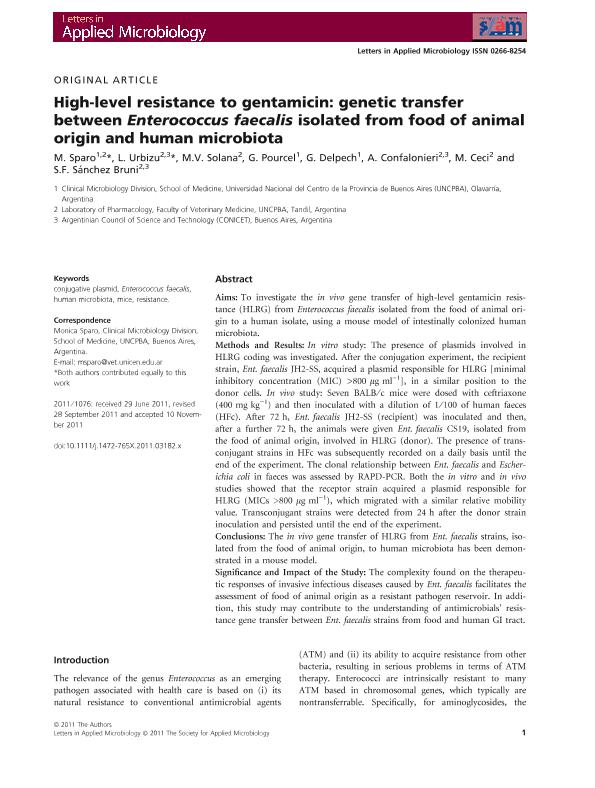Artículo
High-level resistance to gentamicin: Genetic transfer between Enterococcus faecalis isolated from food of animal origin and human microbiota
Sparo, Mónica Delfina; Urbizu, Lucia Paola ; Solana, María Victoria
; Solana, María Victoria ; Pourcel, Natalia Gisela; Delpech, Gastón
; Pourcel, Natalia Gisela; Delpech, Gastón ; Confalonieri, Alejandra
; Confalonieri, Alejandra ; Ceci, M.; Sanchez Bruni, Sergio Fabian
; Ceci, M.; Sanchez Bruni, Sergio Fabian
 ; Solana, María Victoria
; Solana, María Victoria ; Pourcel, Natalia Gisela; Delpech, Gastón
; Pourcel, Natalia Gisela; Delpech, Gastón ; Confalonieri, Alejandra
; Confalonieri, Alejandra ; Ceci, M.; Sanchez Bruni, Sergio Fabian
; Ceci, M.; Sanchez Bruni, Sergio Fabian
Fecha de publicación:
02/2012
Editorial:
Wiley Blackwell Publishing, Inc
Revista:
Letters in Applied Microbiology
ISSN:
0266-8254
Idioma:
Inglés
Tipo de recurso:
Artículo publicado
Clasificación temática:
Resumen
Aims: To investigate the in vivo gene transfer of high-level gentamicin resistance (HLRG) from Enterococcus faecalis isolated from the food of animal origin to a human isolate, using a mouse model of intestinally colonized human microbiota. Methods and Results: In vitro study: The presence of plasmids involved in HLRG coding was investigated. After the conjugation experiment, the recipient strain, Ent. faecalis JH2-SS, acquired a plasmid responsible for HLRG [minimal inhibitory concentration (MIC) >800μgml -1], in a similar position to the donor cells. In vivo study: Seven BALB/c mice were dosed with ceftriaxone (400mgkg -1) and then inoculated with a dilution of 1/100 of human faeces (HFc). After 72h, Ent. faecalis JH2-SS (recipient) was inoculated and then, after a further 72h, the animals were given Ent. faecalis CS19, isolated from the food of animal origin, involved in HLRG (donor). The presence of transconjugant strains in HFc was subsequently recorded on a daily basis until the end of the experiment. The clonal relationship between Ent. faecalis and Escherichia coli in faeces was assessed by RAPD-PCR. Both the in vitro and in vivo studies showed that the receptor strain acquired a plasmid responsible for HLRG (MICs >800μgml -1), which migrated with a similar relative mobility value. Transconjugant strains were detected from 24h after the donor strain inoculation and persisted until the end of the experiment. Conclusions: The in vivo gene transfer of HLRG from Ent. faecalis strains, isolated from the food of animal origin, to human microbiota has been demonstrated in a mouse model. Significance and Impact of the Study: The complexity found on the therapeutic responses of invasive infectious diseases caused by Ent. faecalis facilitates the assessment of food of animal origin as a resistant pathogen reservoir. In addition, this study may contribute to the understanding of antimicrobials' resistance gene transfer between Ent. faecalis strains from food and human GI tract.
Palabras clave:
Conjugative Plasmid
,
Enterococcus Faecalis
,
Human Microbiota
,
Mice
,
Resistance
Archivos asociados
Licencia
Identificadores
Colecciones
Articulos(CIVETAN)
Articulos de CENTRO DE INVESTIGACION VETERINARIA DE TANDIL
Articulos de CENTRO DE INVESTIGACION VETERINARIA DE TANDIL
Citación
Sparo, Mónica Delfina; Urbizu, Lucia Paola; Solana, María Victoria; Pourcel, Natalia Gisela; Delpech, Gastón; et al.; High-level resistance to gentamicin: Genetic transfer between Enterococcus faecalis isolated from food of animal origin and human microbiota; Wiley Blackwell Publishing, Inc; Letters in Applied Microbiology; 54; 2; 2-2012; 119-125
Compartir
Altmétricas



